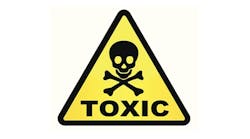How to Keep Toxic Substance Inventories EPA Compliant
Included in the 2016 amendments to the federal Toxic Substances Control Act (TSCA) is a one-time reporting requirement for industry, designed to bring the U.S. Environmental Protection Agency’s (EPA) list of chemicals in commerce—referred to as the “TSCA Inventory”—up to date. The EPA wants to remove any chemicals from the TSCA Inventory that are no longer made or imported into the U.S.
Shortening the current list of more than 85,000 chemicals will help the EPA to meet its principal new obligation under the TSCA amendments—to prioritize and review the safety of all remaining chemicals currently in commerce under their circumstances of use, and to impose risk management controls (anything from warnings to complete bans) where it finds unreasonable risks. The new chemical testing and risk evaluation process will proceed chemical-by-chemical over a long period of time, and many companies may not be affected for several years. But the chemical reporting obligation (TSCA Inventory Reset) will affect nearly every company, including many companies often exempt from other kinds of EPA reporting.
Beginning in the third quarter of 2017, companies of all sizes and in nearly all industries will have 180 days to investigate, identify and report to the EPA each chemical substance that it has manufactured or imported in the past ten years, regardless of the amount. Chemicals not reported as being made or imported during the look-back period will be designated "inactive" and it will be illegal thereafter to manufacture, import, process or use those chemicals in the U.S. unless they are first 'reactivated' by notice to the EPA (with a potential penalty of $37,500/day). Accordingly, all chemical processors and users have an interest in assuring that the chemicals they use are on the “active” list.
The EPA has proposed to give processors an additional six-month window to review the initial list and report any additional chemicals they use that may have been overlooked by suppliers. The EPA’s proposed reporting rules were issued on January 13, 2017 and are open for public comment until March 14. Final rules are expected by June 22.
Six Things to Know about Reporting for the TSCA Reset
- As proposed, each manufacturer and importer has a legal duty to report its activities, even if affiliates or others have reported the same chemical. Special procedures will apply for toll manufacturing or co-importing circumstances. There is no minimum quantity.
- Companies will be responsible for identifying all responsive information that is known or reasonably ascertainable. This includes information in a company's own records, known to its employees or, apparently, obtainable from a supplier.
- Reporting is not required for pesticides, food, drugs, cosmetics, medical devices, R&D materials, impurities, byproducts that are disposed (and not used) and some naturally occurring substances. Substances incorporated into imported articles are exempt unless intended for release (e.g., ink in pens or fragrance in scented items). Non-confidential substances reported to the EPA in the 2012 or 2016 quadrennial chemical data reporting (CDR) events (principally those made or imported in quantities greater than 25,000 lbs./year) are also exempt from reporting.
- Companies must separately report each chemical making up an imported mixture (e.g., commercial cleaning products or metal alloy ingots), as well as isolated intermediates, chemicals extracted from existing substances, and substances that are made unintentionally or coincidentally through secondary or recovery processes and reused in some way by the producing company or downstream recycler.
- New confidentiality claims for the identity of a chemical will not be allowed. Existing chemical identity claims will be allowed to be renewed, subject to a future showing that disclosure would likely cause competitive harm (substantiation). Claims to keep other submitted information confidential (e.g., identity of the submitter) will have to be substantiated with the report.
- If a company in the future wants to start or resume use of an chemical that was not reported and has been deemed “inactive,” it can be ‘reactivated’ by submitting an electronic notice with minimal information no more than 30 days prior to active commercial use.
How to Prepare for the TSCA Inventory Reset
Manufacturers and importers will have a relatively short time to investigate ten years of past chemical activities and prepare and submit reports after the reporting rule is finalized. Companies are advised to assess now what it will require for them to identify all reasonably ascertainable chemical identity and use period information, and to assemble the interdisciplinary team typically necessary, and begin to investigate and catalog materials to be reported.
The process may be relatively simple for companies with only a few static operations over the period. But the investigation may be much more complicated for firms that have worked with a more dynamic range of products over the period, have a diverse set of production and recovery operations, have acquired other companies with relevant historical operations and/or have imported a number of products manufactured by others.
All reporting companies will need a system to manage the investigations of the chemical identity of individual products (including documenting source information and extent of the search to meet recordkeeping requirements). Processors should identify with particularity the substances they currently use, then compare their findings to the initial list of active substances prepared by the EPA based on manufacturers’ reports.
Prepare to Discover and Respond to Compliance Issues
Any company reviewing ten years of past chemical manufacturing and importing is likely to discover some instances of inadvertent regulatory or contractual non-compliance, either wholly in the past, or continuing to the present day. These may include violations of TSCA pre-manufacture notice obligations, TSCA import compliance certifications, TSCA export notifications where required, flawed reliance on TSCA R&D or export-only exemptions, noncompliance with applicable significant use rules, failure to report particular chemicals subject to CDR reporting, inaccurate safety data sheets, non-compliance with applicable State product disclosure labeling (e.g., Prop 65) or State or private contractual restrictions on product chemical content. Planning should include procedures for responding to any such discoveries.
With possibility of such discoveries in mind, forward-looking companies may leverage the otherwise required investigations by coupling them with a voluntary chemical compliance audit. Under the EPA’s audit policy, the audit would give companies the opportunity to promptly disclose and correct any violations discovered without incurring gravity-based penalties. Companies might also use the investigations to better understand the particular chemicals present in and important to their products, and be better prepared to know when proposed state, federal or foreign chemical regulation threatens their interests.
James G. Votaw is an environmental law and product regulation partner in Manatt, Phelps & Phillips’ Washington, D.C. office.




